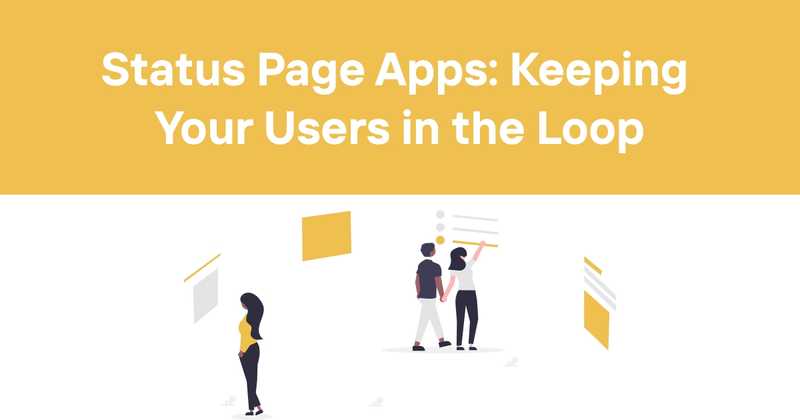Status Page Apps: Keeping Your Users in the Loop (Even When Things Go Sideways)
Let's face it: in the world of tech, stuff breaks. Servers crash, APIs throw tantrums, and sometimes it feels like the digital gods are playing a cosmic game of whack-a-mole with your infrastructure. But here's the kicker - your users don't care about the technical gymnastics happening behind the scenes. They just want to know why their favorite app is acting like it had one too many at the office party.
Enter the unsung hero of the tech world: the status page app. It's like a digital town crier, but instead of shouting "Hear ye, hear ye!" it's calmly telling your users, "Yes, we know the hamsters powering our servers are on strike. We're negotiating with their union rep as we speak."
Table of Contents
- What's a Status Page App Anyway?
- Why You Need a Status Page (Unless You Enjoy Angry Tweets)
- Key Features to Look for in a Status Page App
- Setting Up Your Status Page: A Step-by-Step Guide
- Best Practices for Managing Your Status Page
- Integrating Your Status Page with Other Tools
- The Psychology of Effective Status Communication
- Status Pages in Action: Real-World Examples
- The Future of Status Page Apps
- Choosing the Right Status Page App for Your Needs
What's a Status Page App Anyway?
Picture this: You're a developer, it's 2 AM, and your phone is blowing up with alerts. Your cat, startled by the commotion, knocks over your emergency Red Bull. As you're mopping up the mess and trying to fix whatever digital inferno has erupted, wouldn't it be nice if there was something automatically telling your users, "Hey, we know things are wonky, we're on it!"?
That's where a status page app comes in. It's a dedicated platform that provides real-time updates about the operational status of your services. Think of it as your digital spokesperson, tirelessly informing your users about what's up (or down) with your system.
But it's not just for when things go wrong. A good status page app also showcases your uptime, planned maintenance, and resolved issues. It's like a report card for your tech infrastructure, except instead of grades, you're showing off how reliable you are.
Why You Need a Status Page (Unless You Enjoy Angry Tweets)
-
Transparency is the New Black: Users appreciate honesty. If something's broken, they want to know. A status page shows you're not trying to sweep issues under the rug.
-
Reduce Support Tickets: When users can check a status page, they're less likely to flood your support channels with "Is it just me, or...?" messages.
-
Build Trust: Consistently communicating about your system's health builds credibility. It shows you're proactive and on top of things.
-
Historical Context: Over time, your status page becomes a record of your reliability. It's like a trophy case for your uptime achievements.
-
SEO Benefits: When users search for "[Your Service] down," your status page can appear, giving them official info instead of random forum complaints.
Key Features to Look for in a Status Page App
When shopping for a status page app, you want one that's more feature-packed than a Swiss Army knife, but easier to use than a spoon. Here's what to look for:
-
Real-Time Updates: Your status page should be fresher than your coffee.
-
Customization: Because your brand is unique, and your status page should match.
-
Automated Monitoring: It should be smart enough to know when something's wrong before you do.
-
Component Breakdown: Users should be able to see which specific parts of your service are affected.
-
Incident History: A log of past issues, because those who forget history are doomed to repeat it (and get more angry emails).
-
Subscriber Notifications: Let users opt-in for updates. It's like a newsletter, but people actually want to read it.
-
API Access: For when you want to get fancy and integrate status info into your own apps.
-
Metrics Display: Show off those sweet, sweet uptime percentages.
-
Multi-Language Support: Because downtime is a universal language, but explanations shouldn't be.
-
Mobile-Friendly: For checking status updates on-the-go, or more realistically, from bed at 3 AM.
Setting Up Your Status Page: A Step-by-Step Guide
Setting up a status page doesn't have to be harder than explaining blockchain to your grandma. Here's a simple guide:
-
Choose Your Weapon: Pick a status page app that fits your needs and budget.
-
Customize Your Look: Make it pretty. Or at least on-brand.
-
Define Your Components: Break down your service into logical parts. "Database," "API," "Front-end," "Coffee Machine," etc.
-
Set Up Monitoring: Configure how your status page will check on your components.
-
Create Incident Templates: Pre-write some messages for common issues. Future you will thank present you.
-
Set Up Notifications: Decide how you'll alert your team when things go south.
-
Integrate with Your Tools: Connect your status page to your existing monitoring and communication tools.
-
Test, Test, Test: Create a fake incident. Make sure everything works as smoothly as your sales pitch.
-
Educate Your Team: Make sure everyone knows how to use the status page. Yes, even Dave from accounting.
-
Launch and Promote: Let your users know about your shiny new status page. Put the link everywhere.
Best Practices for Managing Your Status Page
Managing a status page is like tending a garden, if plants could crash and needed constant monitoring. Here are some tips to keep your digital garden blooming:
-
Be Proactive: Don't wait for users to report issues. If you know something's up, say so.
-
Use Plain Language: "Our quantum flux capacitor is experiencing temporal anomalies" means nothing to most people. "The login system is slow" does.
-
Update Frequently: During an incident, silence is not golden. It's annoying.
-
Be Honest: If you messed up, own it. Users appreciate authenticity.
-
Provide Workarounds: If possible, give users temporary solutions while you fix the main issue.
-
Post Post-Mortems: After resolving major incidents, share what happened and how you're preventing it in the future.
-
Monitor Your Monitoring: Regularly check that your automated systems are working. A status page that's always green is suspicious.
-
Use Maintenance Windows Wisely: Schedule updates during low-traffic periods, and communicate them well in advance.
-
Train Multiple Team Members: Don't let your status page become a single point of failure by having only one person who knows how to use it.
-
Gather Feedback: Ask your users how useful they find your status updates. Continuous improvement is key.
Integrating Your Status Page with Other Tools
Your status page shouldn't be a lone wolf. It should play nice with your other tools, like the perfect potluck dish. Here are some integration ideas:
-
Monitoring Tools: Connect your status page to tools like Nagios, Pingdom, or New Relic for automatic updates.
-
Incident Management Platforms: Link it with PagerDuty or OpsGenie to streamline your response process.
-
Communication Tools: Integrate with Slack or Microsoft Teams to keep your team in the loop.
-
Customer Support Software: Connect to Zendesk or Intercom to help your support team stay informed.
-
Social Media: Automatically post status updates to Twitter or Facebook for wider reach.
-
Your Own Website: Embed a status widget on your site for at-a-glance updates.
-
Email Marketing Tools: Use Mailchimp or SendGrid to send status notifications to subscribers.
-
Analytics Platforms: Integrate with Google Analytics to track how users interact with your status page.
-
DevOps Tools: Connect with Jenkins or GitLab for deployment-related updates.
-
Custom Applications: Use the status page API to pull data into your own internal dashboards.
The Psychology of Effective Status Communication
Communicating about system status is as much about psychology as it is about technology. Here's how to speak to the human, not just the user:
-
Empathize: Acknowledge the frustration. "We know this is disrupting your work, and we're sorry."
-
Be Transparent: Hiding information breeds mistrust. Share what you know, even if it's not complete.
-
Set Expectations: If you don't know how long a fix will take, say so. "We're investigating and will update in 30 minutes" is better than silence.
-
Use Appropriate Tone: Serious for major outages, lighter for minor hiccups. But always professional.
-
Provide Context: Explain the impact. "This affects login for 10% of users" is more informative than "Login system issues."
-
Offer Assurance: Let users know you're taking the issue seriously. "Our entire engineering team is focused on resolving this."
-
Follow Up: After resolution, explain what happened and what you're doing to prevent recurrence.
-
Thank Your Users: Show appreciation for their patience and any reported issues.
-
Use Visual Cues: Color-coding (red for outages, yellow for degraded performance, green for all clear) helps quick understanding.
-
Be Consistent: Use the same terminology and update frequency to build familiarity and trust.
Status Pages in Action: Real-World Examples
Let's look at some companies that have turned status page management into an art form:
-
GitHub: Their status page is a masterclass in transparency, with detailed incident reports and system metrics.
-
Slack: They use a clean, easy-to-read design with clear explanations of any issues.
-
Dropbox: Their status page includes a 90-day history, showing long-term reliability.
-
Twilio: They provide granular status updates for different APIs and regions.
-
Shopify: Their page includes scheduled maintenance notices, helping merchants plan ahead.
Remember, a good status page is like a good waiter - always there when you need it, but not intrusive when everything's going well.
The Future of Status Page Apps
As we peer into our crystal ball (which is really just a cracked smartphone screen), what does the future hold for status page apps?
-
AI-Powered Insights: Machine learning could predict issues before they happen, turning your status page into a digital fortune teller.
-
Augmented Reality Integration: Imagine pointing your phone at your server rack and seeing real-time status overlays. It's like Pokémon GO, but for uptime.
-
Voice Assistant Integration: "Alexa, is our database on fire?" "Yes, and it's not even Tuesday."
-
Blockchain-Based Verification: Immutable records of system status, because nothing says "trustworthy" like a buzzword from 2017.
-
Emotional Intelligence: Status pages that can gauge user frustration levels and adjust communication accordingly. "We sense you're about to throw your laptop out the window. Please don't."
-
Holographic Displays: For when a 2D status page just isn't dramatic enough.
-
Gamification: Earn badges for quick incident resolution. "Congratulations! You've unlocked the '99.9999% Uptime' achievement!"
-
Smell-O-Vision Integration: Release calming lavender scents during major outages. (Okay, maybe we're getting carried away now.)
Choosing the Right Status Page App for Your Needs
Picking a status page app is like choosing a sidekick for your tech adventures. Here's how to find your perfect Robin:
-
Assess Your Scale: A small startup and a multinational corporation have different needs. Choose accordingly.
-
Consider Your Tech Stack: Look for easy integration with your existing tools.
-
Evaluate Ease of Use: You want something your entire team can use, not just the one person who still remembers how to program in COBOL.
-
Check Customization Options: Your status page should feel like an extension of your brand, not a generic template.
-
Look at Pricing: Balance features with your budget. Remember, the most expensive option isn't always the best.
-
Read User Reviews: See what others in your industry are using and loving (or hating).
-
Test Drive: Many services offer free trials. Take them for a spin before committing.
-
Examine Support Options: Because when things go wrong with your status page, you need help fast.
-
Consider Future Needs: Choose a solution that can grow with your company.
-
Trust Your Gut: If a status page app feels right and meets your needs, go for it. Sometimes, the simplest solution is the best.
Remember, a good status page app is like a good pair of shoes - it should fit well, support you when things get rough, and hopefully not cause any blisters.
In conclusion, a status page app is more than just a tool - it's a communication lifeline between you and your users. It's your chance to show that even when things go wrong (and they will), you're on top of it. With the right status page app, you can turn potential frustration into appreciation, one update at a time.
And hey, if you're looking for a status page solution that ticks all these boxes (and maybe even invents some new ones), why not give Odown a try? It's got all the bells and whistles you need for top-notch status communication, plus a few extra kazoos just for fun. Because let's face it, if you're going to have downtime, you might as well have a status page that's up to the task.



